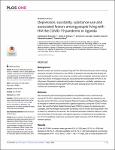Depression, suicidality, substance-use and associated factors among people living with HIV the COVID-19 pandemic in Uganda

View/
Date
2023Author
Rukundo, Godfrey Zari
Wakida, Edith K.
Karungi, Christine K.
Asasira, Jenipher
Kumakech, Edward
Obua, Celestino
Metadata
Show full item recordAbstract
Background
Mental disorders are common in people living with HIV (PLHIV) but they are often unrecog nized and untreated. Furthermore, the COVID-19 pandemic has disrupted the already lim ited mental health services in low resource countries such as Uganda, and yet the extent to
which the COVID-19 mitigation measures have affected the mental health of PLHIV is not
fully known. We aimed to determine the burden of depression, suicidality, substance use
and associated factors among adult PLHIV who were seeking care at two HIV clinics in
northern and southwestern Uganda.
Methods
We conducted a phenomenological qualitative and quantitative cross-sectional study
among 431 PLHIV to determine the burden of depression, suicidality and substance-use
disorders at two HIV clinics, at Lira Regional Referral Hospital and Mbarara Regional Refer ral Hospital in northern and southwestern Uganda respectively, during the COVID-19 lock down. We used the Patient Health Questionnaire (PHQ-9) to assess for depression and
suicidality, and the Michigan Assessment-Screening Test for Alcohol and drugs (MAST-AD)
to assess for substance use disorder. We conducted descriptive statistics analysis to deter mine the burden of the disorders, and logistic regression to determine the associated fac tors. For the qualitative method we conducted in-depth interviews with 30 PLHIV and did
thematic analysis.
Results
Of the 431 PLHIV surveyed, mean age was 40.31 ± 12.20 years; 53.1% (n = 229) had
depression; 22.0% (n = 95) had suicidality; and 15.1% (n = 65) had substance-use disorder.
Female gender (PR = 1.073, 95%CI 1.004–1.148, P = 0.038), lack of formal education (PR0.859–0.994, P = 0.034) and suicidality (PR = 0.757, 95%CI 0.722–0.794, p = 0.000) were
associated with depression after adjusting for confounders. Further analysis showed that
being female (PR = 0.843, 95% CI 0.787–0.903, P = 0.000*) and having depression (PR =
0.927, 95% CI 0.876–0.981, P = 0.009) and owning a large business (PR = 0.886, 95% CI
0.834–0.941, p = 0.000*) were significantly associated with having a substance-use disor der. Only depression was independently associated with suicidality after adjusting for con founding factors (PR 0.108, 95%CI 0.054–0.218, p = 0.000*). For the qualitative results,
there were three apriori themes: a) Burden of depression, b) substance-use, and c) suicidal ity among the PLHIV during the COVID-19 containment measures.
Conclusion
There was high prevalence of depression, suicidality and substance-use disorder in adult
PLHIV in Uganda during the COVID-19 pandemic and the associated lockdown measures.
The three mental health problems seem to have bidirectional relationships and gender has
a lot of contribution to the relationships. Interventions aimed at any of the disorders should
consider these bidirectional relationships.
Collections
- Research Articles [36]
